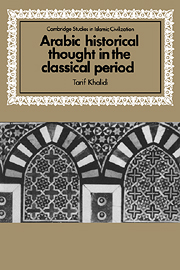5 - History and Siyasa
Published online by Cambridge University Press: 23 November 2009
Summary
The temporal boundaries of the present chapter lie roughly between the eleventh and fifteenth centuries. These are centuries immensely rich in primary sources, a fact which is itself a reflection of times considered stirring and even unparalleled by contemporaries. This sense of the uncommonness of the hour will be our starting point, for it serves to demarcate a new attitude to history among its practitioners. Whereas earlier historiography was largely an interpretation of a momentous past, the new historiography boldly projected its own present as being of equal if not greater significance. This tone is well captured in the history of the reconquest of Jerusalem written by Saladin's secretary of state, eImad al-Din al-Katib al-Isfahani (d. 597/1201):
I began this historical record at the beginning of the year 583 [1187] because histories usually begin either with the creation of mankind or with the succession of states … Were it not for history, the endeavours of men of sound policies (siyasat fadila) would all be in vain and praise or blame would not be the criterion by which to judge them … I, on the other hand, chose to date my history from a second Hijra … this Hijra being the Hijra of Islam to Jerusalem, undertaken by the Sultan Salah al-Din … History would do well to be dated from this year … Indeed this Hijra is of more lasting significance (abqa) than the first … My testimony is based entirely on what I witnessed … and I have been concerned to record only what I myself experienced.
- Type
- Chapter
- Information
- Arabic Historical Thought in the Classical Period , pp. 182 - 231Publisher: Cambridge University PressPrint publication year: 1994

